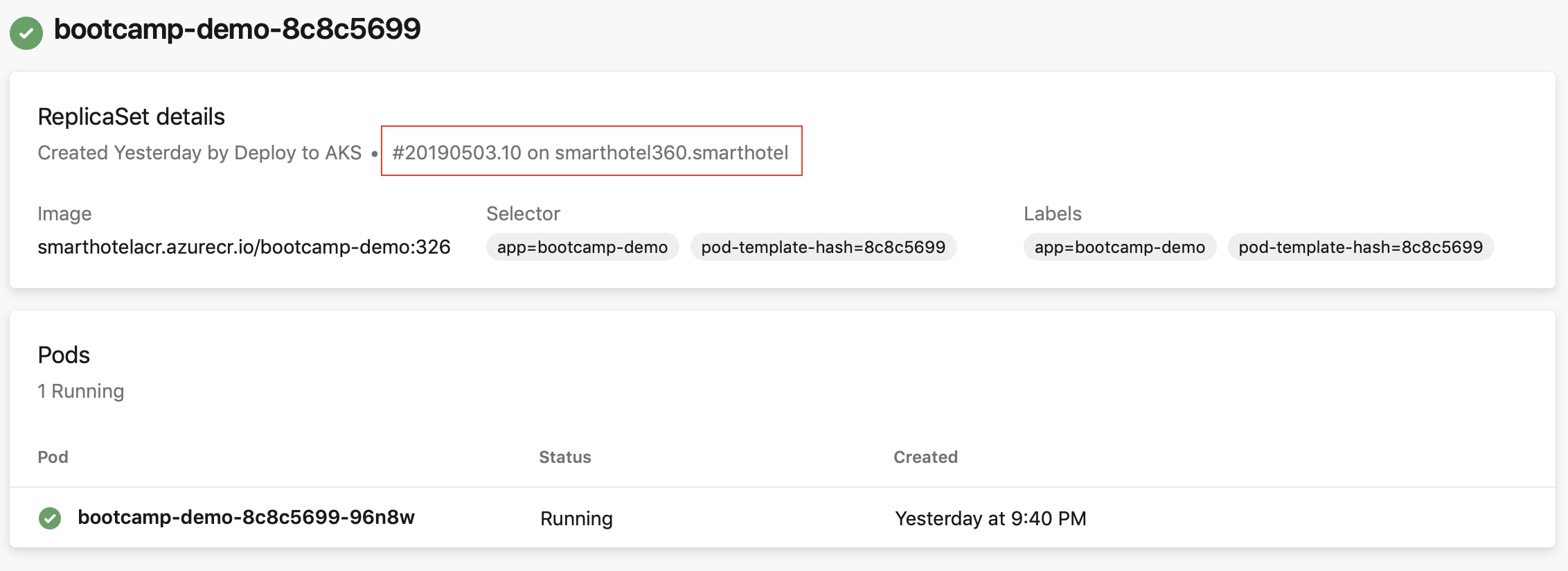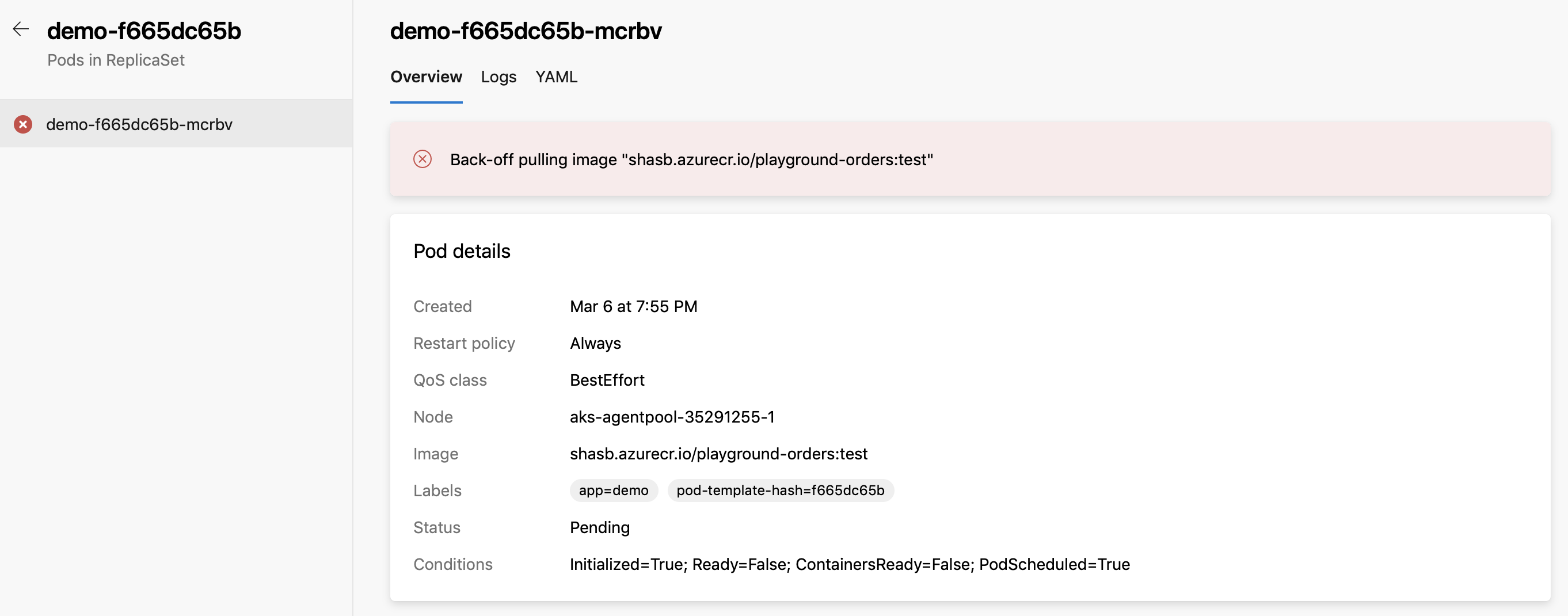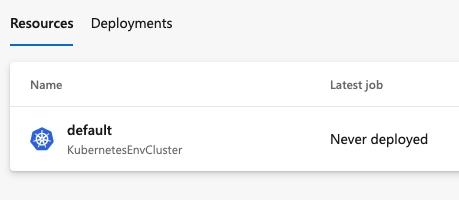Note
Access to this page requires authorization. You can try signing in or changing directories.
Access to this page requires authorization. You can try changing directories.
Azure DevOps Services | Azure DevOps Server | Azure DevOps Server 2022
This article describes using Kubernetes resources in Azure Pipelines environments that you can target with deployments. You can connect to public or private Kubernetes clusters in Azure Kubernetes Service (AKS) or other cloud providers.
Environment resource views show Kubernetes resource status and provide traceability to the pipeline and back to the triggering commit. You can also create dynamic Kubernetes environment resources to review pull requests before merge. For more information about environment resources, see Resources in YAML pipelines and Resource security.
Note
A private AKS cluster doesn't expose its API server endpoint through a public IP address, so you must connect to the cluster's virtual network. You can set up a self-hosted agent within a virtual network that can access the cluster's virtual network or use Managed DevOps Pools. For more information, see Options for connecting to a private cluster.
Kubernetes environment resource advantages
Kubernetes environment resources and resource views in environments provide the following benefits:
Pipeline traceability. The Kubernetes manifest deployment task adds annotations that support pipeline traceability. You can see the Azure DevOps organization, project, and pipeline responsible for updates to objects within the namespace.

Resource health diagnostics. The workload status view is a quick way to debug mistakes or regressions introduced by new deployments. For example, pod status information can help you identify the cause of issues like unconfigured
imagePullSecretsthat result inImagePullBackOfferrors.
Review app. The review app deploys every pull request from your Git repository to a dynamic Kubernetes resource in the environment, and posts a GitHub comment linking to the review app. Reviewers can see how the PR changes look and work with other dependent services before the changes are merged into the target branch and deployed to production.

AKS resources
AKS creates a ServiceAccount in your chosen cluster and namespace, and maps Kubernetes resources in your environment to the specified namespace. For information about setting up a Kubernetes service connection outside of an environment, see Kubernetes service connection.
For a Kubernetes role-based access control (RBAC)-enabled cluster, RoleBinding is also created to limit the scope of the service account to the chosen namespace. For a Kubernetes RBAC-disabled cluster, the created service account has cluster-wide privileges across namespaces.
To add an AKS resource to an Azure Pipelines environment:
On the environment's page under Pipelines > Environments, select Add resource and then select Kubernetes.
On the next screen, select Azure Kubernetes Service for the Provider, and then select your Azure subscription, AKS Cluster, and new or existing Namespace. For a new namespace, enter the namespace name.
Select Validate and create. The new resource appears on the environment's Resources tab with the text Never deployed.

Non-AKS Kubernetes resources
To map a Kubernetes resource from a non-AKS cluster to a namespace, you need to have an existing service account for the non-AKS provider.
To add a non-AKS Kubernetes resource to an Azure Pipelines environment:
On the environment's page under Pipelines > Environments, select Add resource and then select Kubernetes.
On the next screen, select Generic provider (existing service account) for the Provider.
Under Cluster credentials, enter the Cluster name, Namespace, Server URL, and Secret.
To get the server URL, run
kubectl config view --minify -o jsonpath={.clusters[0].cluster.server}in your local shell.To get the secret:
- Get service account secret names by running
kubectl get serviceAccounts <service-account-name> -n <namespace> -o=jsonpath={.secrets[*].name}. - Run
kubectl get secret <service-account-secret-name> -n <namespace> -o jsonusing the output of the preceding command.
Note
If you get no results from the
get ServiceAccountscommand, see Manually create a long-lived API token for a ServiceAccount.- Get service account secret names by running
Select Validate and create.
Kubernetes resources in pipelines
The easiest way to create a YAML pipeline to deploy to AKS is to start with the Deploy to Azure Kubernetes Services template. You don't have to write YAML code or manually create explicit role bindings. The generated pipeline sets and uses variables and other values based on your configuration settings.
Use the review app
The DeployPullRequest job deploys every pull request from your Git repository to a dynamic Kubernetes resource in the environment. To add this job to the pipeline, select the check box for Enable Review App flow for Pull Requests in the Deploy to Azure Kubernetes Services configuration form.
Note
To add this job to an existing pipeline, make sure the service connection backing the regular Kubernetes environment resource is set to Use cluster admin credentials. Otherwise, role bindings must be created for the underlying service account to the review app namespace.
Review app resources are labeled Review in the environment's Resource listing.

Example pipeline
The following example pipeline is based on the Deploy to Azure Kubernetes Services template. The pipeline first builds and pushes an image to Azure Container Registry.
The first deployment job then runs for any commits to the main branch, and deploys against a regular Kubernetes resource in the environment.
The second job runs when a PR is created or updated to the main branch, and deploys against a dynamic review app resource it creates in the cluster on demand.
# Deploy to Azure Kubernetes Service
# Build and push image to Azure Container Registry; Deploy to Azure Kubernetes Service
# https://docs.microsoft.com/azure/devops/pipelines/languages/docker
trigger:
- main
resources:
- repo: self
variables:
# Container registry service connection established during pipeline creation
dockerRegistryServiceConnection: '12345' # Docker service connection identifier
imageRepository: 'name-of-image-repository' # name of image repository
containerRegistry: 'mycontainer.azurecr.io' # path to container registry
dockerfilePath: '**/Dockerfile'
tag: '$(Build.BuildId)'
imagePullSecret: 'my-app-secret' # image pull secret
# Agent VM image name
vmImageName: 'ubuntu-latest'
# Name of the new namespace being created to deploy the PR changes.
k8sNamespaceForPR: 'review-app-$(System.PullRequest.PullRequestId)'
stages:
- stage: Build
displayName: Build stage
jobs:
- job: Build
displayName: Build
pool:
vmImage: $(vmImageName)
steps:
- task: Docker@2
displayName: Build and push an image to container registry
inputs:
command: buildAndPush
repository: $(imageRepository)
dockerfile: $(dockerfilePath)
containerRegistry: $(dockerRegistryServiceConnection)
tags: |
$(tag)
- upload: manifests
artifact: manifests
- stage: Production
displayName: Deploy stage
dependsOn: Build
jobs:
- deployment: Production
condition: and(succeeded(), not(startsWith(variables['Build.SourceBranch'], 'refs/pull/')))
displayName: Production
pool:
vmImage: $(vmImageName)
environment: 'myenvironmentname.myresourcename'
strategy:
runOnce:
deploy:
steps:
- task: KubernetesManifest@1
displayName: Create imagePullSecret
inputs:
action: createSecret
secretName: $(imagePullSecret)
dockerRegistryEndpoint: $(dockerRegistryServiceConnection)
- task: KubernetesManifest@1
displayName: Deploy to Kubernetes cluster
inputs:
action: deploy
manifests: |
$(Pipeline.Workspace)/manifests/deployment.yml
$(Pipeline.Workspace)/manifests/service.yml
imagePullSecrets: |
$(imagePullSecret)
containers: |
$(containerRegistry)/$(imageRepository):$(tag)
- deployment: DeployPullRequest
displayName: Deploy Pull request
condition: and(succeeded(), startsWith(variables['Build.SourceBranch'], 'refs/pull/'))
pool:
vmImage: $(vmImageName)
environment: 'myenvironmentname.$(k8sNamespaceForPR)'
strategy:
runOnce:
deploy:
steps:
- reviewApp: default
- task: Kubernetes@1
displayName: 'Create a new namespace for the pull request'
inputs:
command: apply
useConfigurationFile: true
inline: '{ "kind": "Namespace", "apiVersion": "v1", "metadata": { "name": "$(k8sNamespaceForPR)" }}'
- task: KubernetesManifest@1
displayName: Create imagePullSecret
inputs:
action: createSecret
secretName: $(imagePullSecret)
namespace: $(k8sNamespaceForPR)
dockerRegistryEndpoint: $(dockerRegistryServiceConnection)
- task: KubernetesManifest@1
displayName: Deploy to the new namespace in the Kubernetes cluster
inputs:
action: deploy
namespace: $(k8sNamespaceForPR)
manifests: |
$(Pipeline.Workspace)/manifests/deployment.yml
$(Pipeline.Workspace)/manifests/service.yml
imagePullSecrets: |
$(imagePullSecret)
containers: |
$(containerRegistry)/$(imageRepository):$(tag)
- task: Kubernetes@1
name: get
displayName: 'Get services in the new namespace'
continueOnError: true
inputs:
command: get
namespace: $(k8sNamespaceForPR)
arguments: svc
outputFormat: jsonpath='http://{.items[0].status.loadBalancer.ingress[0].ip}:{.items[0].spec.ports[0].port}'
# Get the IP of the deployed service and writing it to a variable for posting comment
- script: |
url="$(get.KubectlOutput)"
message="Your review app has been deployed"
if [ ! -z "$url" -a "$url" != "http://:" ]
then
message="${message} and is available at $url."
fi
echo "##vso[task.setvariable variable=GITHUB_COMMENT]$message"